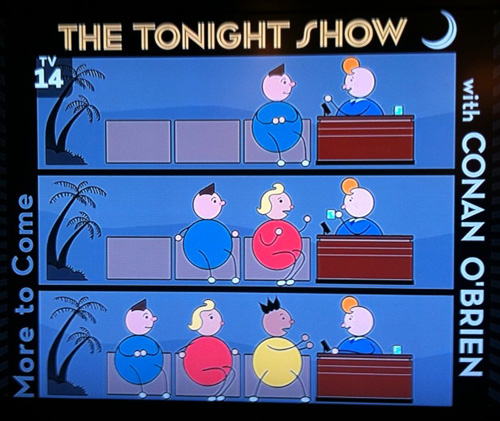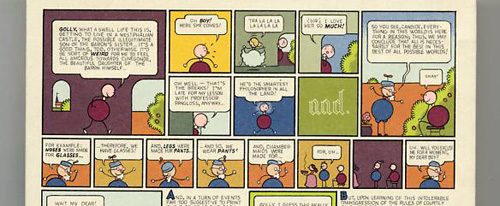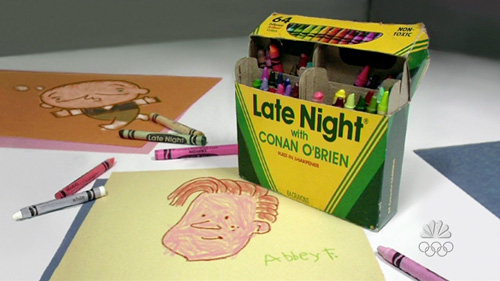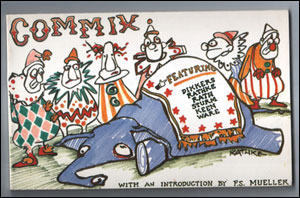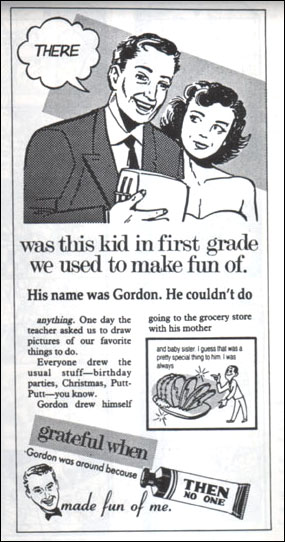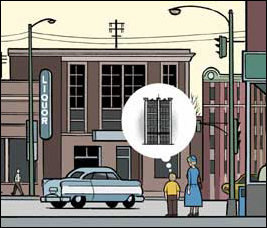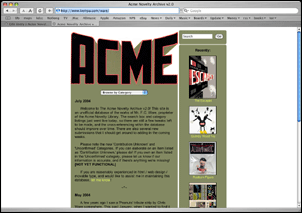Ira Glass: One of the things I find myself – as somebody who does radio – always responding to and really aware of in, in your comics, in a way, in fact, I’ve never really noticed in other comics is um, that there are pauses built in. Like in the thing you just read, the guy will say something in one panel and then there will be a panel where nobody says anything and Jimmy just sits there, and then the next thing will happen. It’s like you’re building in, you’re building in a moment in between, like you’re building in pauses, you’re controlling time and the speed of the reading.
Chris Ware: I think that just comes from, from drawing – first of all without using words, and then trying to give it a real sense of the rhythm of life. And I can’t use any other word to describe it, but there’s a certain – when I’m drawing a strip, it has to have a certain rhythm to it and I basically play through it while I’m reading it, almost like a piano roll, and if I read through it and that there’s a pause in it or there’s a rhythm in it that seems wrong, I’ll subdivide a panel to put in a space, or –
Ira Glass: You’ll actually put in a panel, which is, which will space it out?
Chris Ware: Yeah. I mean, I would think it would be analogous to what you’re doing when you’re editing an interview so that it sounds natural and if somebody, you know, coughs or burps or whatever, or they say something embarrassing –
Ira Glass: Well then, well actually, well actually, like – somebody will talk and be making their big point and you just feel like – as a producer, you feel like, “Oh, I want to slow them down.” Because, because the point will have more emotion and will come across to the listener with the emotion that the person’s feeling more if you slow them down. And so, we’re constantly taking, like, these tiny little pieces of – of blank time and inserting it between words to change the pacing.
Chris Ware: Wow.
Ira Glass: Yeah. [audience laughter]
Chris Ware: That sounds – wow – [audience laughter] Is that legal, though? [audience laughter] I mean, it almost seems like that would be –
Ira Glass: It’s lying.
Chris Ware: – prosecutable, you know.
Ira Glass: Well, we had the quote the same. I mean, one of the things about audio – [audience laughter and applause] – one of the things about audio that’s um, particular and different than other media is that you can edit, you can edit those, you can edit out a phrase, you can move a phrase to another place – as long as, like, they keep a certain, sort of, pitch and speed of their voice. Like, there’s so much manipulation you can do. And so the version of – like sometimes people will say, “Well, how come the people on public radio just seem so much more
articulate than people you meet?” And it’s because, man, we have edited out everything extraneous. You know, they’re talking better than they’ve ever talked in their lives. You know? And, and uh, you know, we’re making a more perfect version of them than could ever exist in nature. And – [audience laughter] And my feeling about it is like, it’s, it’s, it’s such an artificial, um, it’s such an artificial thing to sit down and tape somebody to start with. Like, you’re already not getting the real person; do you know what I mean? You’re already getting this weird approximation of parts of their personality that they feel comfortable saying in the presence of a near stranger with a tape going for an audience of a million people. Like, already – like, that’s such a weird thing that, um, to get at something where it seems like that, that they’re talking about something that means something to them and to make it come across right, putting in a pause here and there doesn’t seem like that much more manipulative than the act of recording itself. Suddenly I sound like Michel Foucault. Do you know what I mean? Like, it’s already so artificial. So I go, pshaw, a pause. They’re not ever gonna know. They just gonna think, “God, I am such, I am so expressive. Like, I left that interview, and I knew – I knew I nailed that interview with that boy, but I really nailed it. And when you put the music underneath, man, it just -.” You know? If there could be music underneath all the time…you know what the music is in the radio story? Music is like the frames on the page. Like the music actually takes it and makes it – the music takes it and makes it into something, which is larger than itself. It’s like it puts a frame around the picture, suddenly you see it as – as a cinematic thing, or you hear it as a cinematic thing when the music comes in.
Chris Ware: Well, you’re the first person I’ve ever noticed that’s ever done that – basically, where you can tell where somebody is actually about to start to tell a story, where there might be an introductory line, and then the music starts and you know that, “OK, this is the – this is where it begins.” It almost – it feels cinematic, but I’ve never heard anyone else do that before.
Ira Glass: Yeah, if you put the music in at a certain place it just creates this feeling of motion, “OK, now we’re going somewhere.” And then one of the tricks we use a lot is that if there’s music playing underneath somebody and you pull it out, whatever they say next, over the silence, sounds more important, and you pay more attention to unconsciously. And so, as a producer, if you want to be sure that people get this point, like this is the point, they must get this, or the rest of this isn’t going to work, or this is the really – like this is the most surprising thing they said, and you want to be sure that it comes across with the power that you’re feeling it, as the person putting it together, you totally pull out the music and maybe put in a little extra pause here or there.
Because you’ve only got your sound and your silence, you know, it’s like – a pretty primitive medium, you’ve got your sound, you’ve got your silence, and so you’ve got to encase the sound around..
Chris Ware: That’s true. Gee! You sound like aesthetic fascists up here, or something.
This is just a giant pull quote – you really should read the whole thing.
